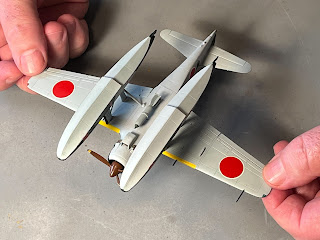On 5 February 1945, following a review exercise by the Aviation Industry Association's (AIA) 6th Sub-Committee of the 2nd Chemical Industry Association a new single National Aircraft Standards was issued entitled ‘Japan Aircraft Standard 8609: Aircraft Paints, Standards by Color’. The AIA was a cooperative body of the Ministry of Munitions Air Weapons General Bureau formed in January 1944. This achieved a reduction from the 54 colours in the IJN Kariki 117 (revised) of April 1942 and the more than 40 colours in the Army Aircraft Materials Standard No.39 of 1935 down to 26 colours with some compromise. For example the Army # 27 Ao Midori iro - 青緑色 (Blue Green colour) was succeeded by the similar IJN D2 which was re-designated as 1-2. Colour D1 was not represented in the revised system and it is apparent that by that time a dark green colour closer to D2 in appearance was being applied as the standard IJN upper surface colour. In the new numbering system the prefix indicated the hue and the suffix the specific colour value within that group, with greens represented by colour swatches 1-1 to 1-5 and greys by colour swatches 2-1 to 2-7. In each case the new colours were designated either as direct successors to the previous colours, and identical to them, or as being similar to them, and presumably acceptable as alternatives. The original colour swatches in the 8609 standard are 14.4 cm x 9.1 cm in size.
The respected Japanese researcher and film director Sunao Katabuchi has asserted (in Scale Aviation magazine, February 2021) that D2 was adopted by the IJN in November 1941 for the camouflage of aircraft flying over the ocean and in the later phase of the war was applied to the upper surfaces of almost all IJN aircraft including Zeros and trainers. However according to Yoshihito Kurosu: 'the 'Hiko-ki Keikaku You-ryou-sho Kaitei-an' (Proposal for the revisions of aircraft planning procedures) issued by Navy Air Command HQ in March 1944 has a table of standard colors and codes under "Kari- kikaku 117 Shiki-betsu Hyojun" (Provisional Standard 117 Color Norms). The table specified the upper-surface color as D1 'an-ryokushoku' (暗緑色 - dark green).
The official name for D1 was 'Deep Green Black' and not 'dark green' but the inconsistency of colour terminology in official Japanese documents, both IJA and IJN , is typical and can present ambiguity. D1 was not included in the 8609 colour standard of Feb 1945 but only D2 (becoming 1-2), which tends to lend credence to Katabuchi-san's assertion.
This year the Japanese Aeronautic Association Aviation Heritage Archive published a most magnificent book on the recent Kawasaki Ki-61-II restoration with amongst its many superlatively documented and presented details of the airframe and engine includes actual spectrophotometer measured L*a*b* values of the 8609 Standard colour swatches reported for the first time, and full size representations of the swatches. They include 1-2 the successor colour to the IJN's D2 and 2-6 the successor colour to their J3 (and reported to be identical). Those important measurements have now been converted to sRGB with the rendered swatches presented below. The swatches have probably become slightly darker and more brownish due to being stored out of light for over 70 years but as shown they are the most authentic and accurate reproductions of the actual 8609 swatches compared to many misleading photo comparisons and facsimiles in magazines, etc. Whether the J3 colour was deliberately made dark to allow for the inevitable chalking* and lightening of the paint surface is moot. But do please note that the 1942 0266 report on camouflage trials conducted at Yokosuka described the then currently applied Zero colour as 'J3 Haiiro (飴色 - ash colour, grey) leaning slightly towards Ameiro' (飴色 - amber, yellowish-brown). Other 8609 colour swatches will be analysed and presented here in due course. A full verification and comparison exercise to other colour standards, including Munsell, has not yet been completed due to personal circumstances.

The current 'go to' fad of using Gunze Mr Color 35 to represent 2-6/J3 is misleading. A better match is to use Mr Color 70 RLM 02, perhaps lightened a little.
One important point to bear in mind is the difference between a colour standard, representing the hue as authorised, and the actual applied paints which could and did vary for many reasons, both as applied and from subsequent exposure and other conditions in service. Also it is improbable that the swatches, intended simply to show colour, were created with the same pigments and components as the actual paint coatings applied to aircraft by manufacturing companies such as Mitsubishi, where protection and serviceability would be considerations beyond just colour hue. Another point to make is that the subject has long been clouded by an equivalence made between subjective opinion versus objective scientific facts and data. The resistance to the latter by the former, often driven by presumption and preference, is effectively impossible to overcome.
* In ‘chalking’ the polymer of the paint is eroded and a powdery patina appears over the surface. Where the white pigment titanium dioxide is present in the paint (in rutile form) as with the Zero the condition is usually exacerbated. “The photochemically active titanium dioxide is both a UV-activated oxidation catalyst and a UV absorber. Free radicals are formed at the surface of the titanium dioxide and these then oxidise the (paint) binder by photocatalytic degradation. This reduces the gloss and produces a friable layer on the surface of the paint film - the process called ‘chalking’.” - The Chemistry and Physics of Coatings, A J Marrion, Royal Society of Chemistry 2004. The effects of chalking, very prevalent in coatings exposed to persistent high temperatures and humidity as well as sunlight are often confused with the fading of colour pigments, an entirely separate process.
Image credit: Schematic © 2023 Aviation of Japan


















































